|
Week ending: 30th July 2023: Stevenston, Saltcoats and Irvine Harbour
With heavy and persistent rain predicted for Sunday I decided to “make hay while the sun shone”
on Friday instead, since the weather was dry, sunny and very mild. I nipped across to Stevenston
to check out the Point and the sand dunes at Stevenston beach. Unfortunately John couldn’t
make it so, with only one pair of eyes, I had to take care not to miss potential sightings.
At Stevenston Point the Sun was following the script and shining magnificently. The wind though
was a bit stiff, but bearable. As usual, there were Oystercatchers sheltering on the Point’s rocky
tip and there were plenty of gulls circulating the area. I walked around the perimeter searching for
small waders and I wasn’t disappointed. About twenty Ringed Plovers and a similar
number of Sanderlings were standing at the water’s edge between the rocks, fairly
camouflaged but ever vigilant. Taking great care not to send them up, I managed a few shots
before they were disturbed by the arrival of a noisy family pointing at them. I then noticed some
lovely patches of Wild Thyme and Eyebright flowering along the west edge of the promontory.
| Oystercatcher |
Lesser Black - backed Gull |
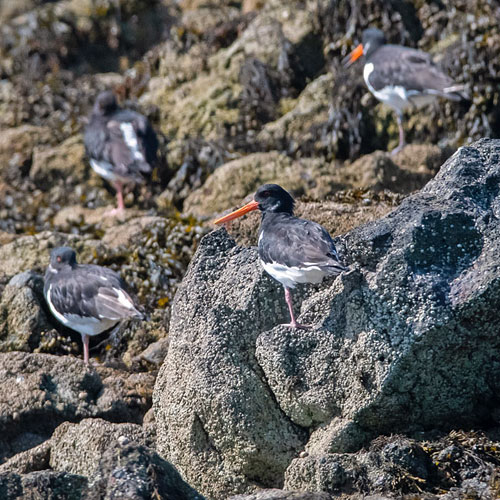 |
 |
| Ringed Plover |
Sanderling |
 |
 |
| Eyebright |
Wild Thyme |
 |
 |
Below is the view to the west, looking over Stevenston beach toward Saltcoats. Note the choppy
waves whipped up by the turbulent wind.
Along the eastern side, I snapped a passing Black-headed Gull. A young tweeting Pied Wagtail
landed near a puddle in front of me, but a good bit further away a Linnet stood on a boulder and
then dashed out over the rocks to the south of the Point. I got a pleasing shot of a large Lesser
Black-backed Gull that was standing regally on a large concrete block. A beautiful Small
Tortoiseshell butterfly began feeding on Common Ragwort and produced some delightful shots.
Back at the car I got another decent shot, this time of an Oystercatcher flying over rocks to join its
flock.
| Black - headed Gull |
Female Pied Wagtail |
 |
 |
| Linnet |
Lesser Black - backed Gull |
 |
 |
| Small Tortoiseshell Butterfly |
Oystercatcher |
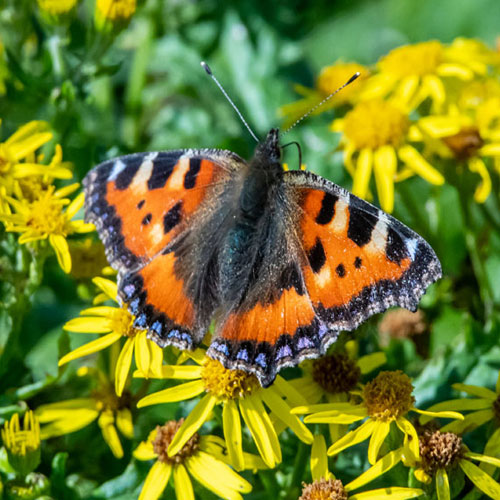 |
 |
I noticed that some Sanderlings had returned to shelter on the west side.
I sat for a while sea-watching at the end of the Point. There had been recent reports of Manx
Shearwaters along the Ayrshire coast but I didn’t see any. I was treated to the passage of a lovely
Gannet, a dashing Shag and a Common Gull. Also, as I returned to the car, a clump of Red
Poppies caught my eye. On my way off the Point, along the single track road, I noticed a few
Jackdaws foraging on the grass verges. I stopped the car to snap a few shots and as a bonus I
also got shots of a Small White butterfly as it fed on Sea Radish flowers.
| Gannet |
Shag |
 |
 |
| Common Gull |
Red Poppy |
 |
 |
| Jackdaw |
Small White Butterfly |
 |
 |
I wasn’t finished though. When I was getting into the car, a flock of excited Starlings descended
onto a large puddle on the road and proceeded to bathe wildly.
After the Point I drove the very short distance to the Stevenston beach car park and walked
along the path that leads to the dunes. I was watched by a pair of Stonechats that probably
had a nest nearby. The path is lined with Beach Roses that were attended by lots of Honey Bees
that seemed to be quite delirious as they wriggled around the rose flower stamens. I was also
impressed by groups of striking blue Harebell flowers along the path edges. I turned onto a path
that leads along part of the dunes and I spotted a solitary Creeping Thistle standing proudly.
| Female Stonechat |
Male Stonechat |
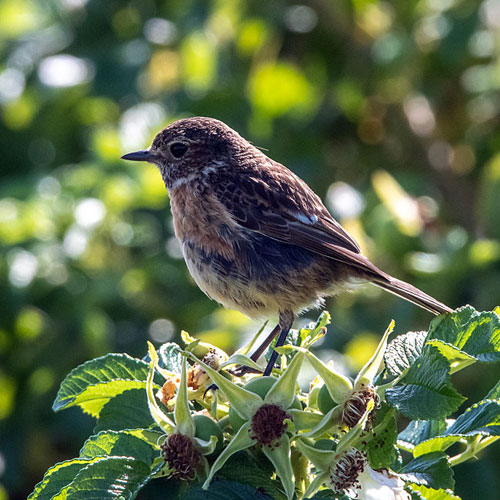 |
 |
| Honey Bee |
Japanese Rose Fruit |
 |

|
| Harebell |
Creeping Thistle |
 |
 |
Below is the view from high on the dunes, looking over Stevenston Beach towards Saltcoats
Harbour. Note the Isle of Arran in the background.
On my return path I came upon a pair of copulating Small Heath butterflies. I later managed a
shot of a single Small Heath sitting on the sandy path. On the same path there was a
Grayling butterfly, a bit of a rarer find (although I would have been disappointed not to find
it). On the same stretch of path I also found a Dune Brittlestem mushroom and some Sheep’s-bit
I relocated a few miles west to Saltcoats Harbour and parked within a few metres a Black
Guillemot resting on the harbour’s edge. A walk to the tower at end of the harbour began
with a shot of the Guillemot flying out of the harbour after being disturbed by a dog walker. At the
tower I caught a surfacing Shag and, unexpectedly, a surfacing Grey Seal. Unfortunately men in
high-viz jackets were walking on the rocks on the other side of the harbour. I got the impression
they could have been looking for bird carcasses. There certainly were no live birds as they
probably scared them away.
A view from the tower of the harbour mouth. A yellow jacket can be seen on the right.
My final stop of the visit was Irvine Harbour. The sky had clouded over but on leaving the car I
noticed a bit of a commotion on the far bank at the confluence of the River Irvine and River
Garnock. A Lesser Black-backed Gull was repeatedly swooping down on a large Grey Heron.
Possibly the gull was defending a nest or chicks in the area. Also, there were at least half a dozen
Grey Seals lying on a barge further upstream on the Garnock. After photographing these I got a
nice flight shot of a Shag as it flew up the Irvine. Rain was threatening so I decided to call it a day
just as I saw several patches of small Henbit Deadnettle growing by the side of the
promenade.
Back in the car, as I had a wee cup of tea and a chocolate biscuit, I managed my last shot of the
trip: a Rook that was hanging about the cars for feeding opportunities.
It turned out that I made the right decision in travelling on Friday rather than Sunday because
Sunday’s weather was wild, wet and windy. Hopefully John will be accompanying me next
Sunday and maybe we’ll get another good weather day.
Week ending: 23rd July 2023: Dalzell Estate (Map) and RSPB Barons Haugh
(Map)
John was unavailable this week and the type of weather predicted for Sunday was wild, wet and
windy. The midweek prediction was much better, so I thought that I’d make two brief solo trips to
RSPB Baron’s Haugh (Website) and the neighbouring Dalzell Estate (Website) on Tuesday and
Wednesday.
Tuesday was a bit on the dull side, but it was mild and dry with only a faint breeze. At the Barons
Haugh car park I got off to a fine start. Two Magpies, and adult and juvenile were hanging around
the cars. I noticed that the ranger had two large planting tubs of wild flowers near at the rear exit
of the car park. Most of the flowers had insects on them. I got photos of a Syrphus ribesii hoverfly
stationary above a Field Scabious flower and also of a Buff-tailed Bumblebee busy of a
flowerhead of White Clover. There was also a Wild Carrot flowerhead carrying a 7-spot Ladybird,
the Greenbottle, Lucilia caesar and a Common Soldier Beetle.
| Magpie... |
Juvenile |
 |
 |
| Hoverfly - Syrphus ribesii |
Buff - tailed Bumblebee |
 |
 |
| 7 Spot Ladybird |
Red Soldier Beetle |
 |
 |
At the Marsh Hide there weren’t many birds about, however I did get shots of a Green-veined
White butterfly and bumblebee on Teasel. I also found Lesser Burdock in flower. On my way to the
next hide, the Causeway Hide, I spied a drake Mallard in eclipse plumage resting in a flooded and
shady ditch not too far from the main path.
| Female Green - veined White Butterfly |
Teasel |
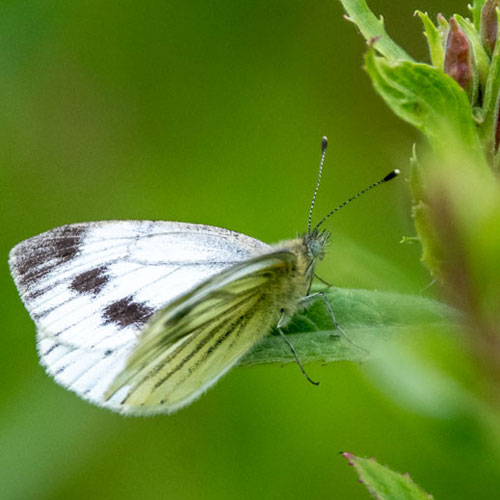 |
 |
| Lesser Burdock |
Mallard in Eclipse plumage |
 |
 |
At the Causeway Hide there were many other Mallards scattered around the Haugh. As well as
quite a few noisy Lapwings. I also noticed about half a dozen Green Sandpipers foraging
around the muddy areas. A few juvenile Moorhens were doing the same. A helpful chap, who was
also scanning the Haugh, pointed out a Common Snipe that was sitting on top of a fence
post about 60m in front of the hide.
| Mallard in Eclipse plumage |
Lapwing |
 |
 |
| Green Sandpiper |
Juvenile Moorhen |
 |
 |
| Common Snipe |
Cormorant |
 |
 |
Below is a view from the Causeway Hide.
When I left the hide I briefly visited the site of the now demolished Phoenix hide in order to view
the Haugh from its raised position. I was disappointed that I didn’t see much that took my
interest. However it wasn’t a wasted effort since I spotted a flowering Broad-leaved Helleborine , a member of the Orchid family. On the walk back to the car park I passed a pair of mating
Common Blue Damselflies drifting and eventually coming to rest on a grass stalk. I also came
across a large umbilifer, Wild Angelica, at the side of a field. On the path at the top of the slope,
before it passes through the gap in the trees, I heard twittering Goldfinches. After a short search I
located them on a Hawthorn in the middle of the adjacent field.
| Broad - leaved Helleborine |
Common Blue Damselfly |
 |
 |
| Wild Angelica |
Goldfinch |
 |
 |
That was the last shot before driving home. I returned on the following day, eager to get going again
since it was a much brighter day. Again I started snapping in the car park after a second look at
the tubs of wildflowers. There was a Buff-tailed Bumblebee on Wild Marjoram flowers and I also
found a patch of French Cranesbill at the other side of the hedgerow. I decided to start my
clockwise circuit of the reserve by passing through Dalzell Estate just east of the car park. As I set
off, a pair of Grey Squirrels were searching the park litter bin for food scraps. One of them was
rather reluctant to move when I approached, giving me another nice photo-opportunity. Pleased
with this I crossed the road into the Dalzell Estate and immediately found a Meadow Brown
butterfly on some Bramble flowers
| Buff - tailed Bumblebee |
French Cranesbill |
 |
 |
| Grey Squirrel |
Meadow Brown Butterfly |
 |
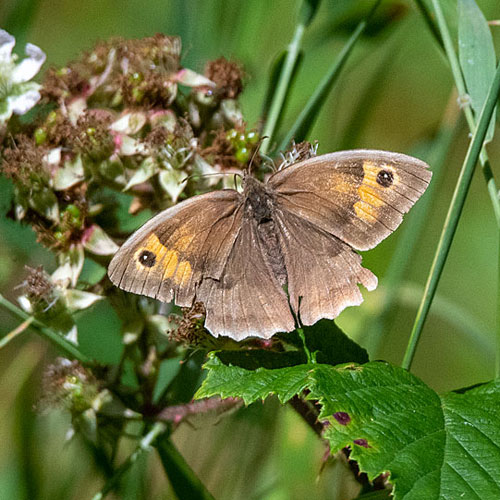 |
This is the view from the ornamental bridge at the Japanese garden looking down the tree-lined
avenue that lead to Dalzell House.
There was yet another Grey Squirrel sitting on top of a tree stump feeding on seeds or nuts left by
another walker. I proceeded through the estate down to the path by the River Clyde where I saw a
Wren with a mouthful of what looks like a moth. A passing walker told me of an Otter he’d just
seen some 200m upstream so I paced up there but to no avail. There was no sign of it, only a few
Mallards were on the water. I hung about there on my wee 3-legged stool and was rewarded with
a fairly close shot of a low-flying Buzzard.
| Grey Squirrel |
Wren |
 |
 |
| Mallard |
Common Buzzard |
 |
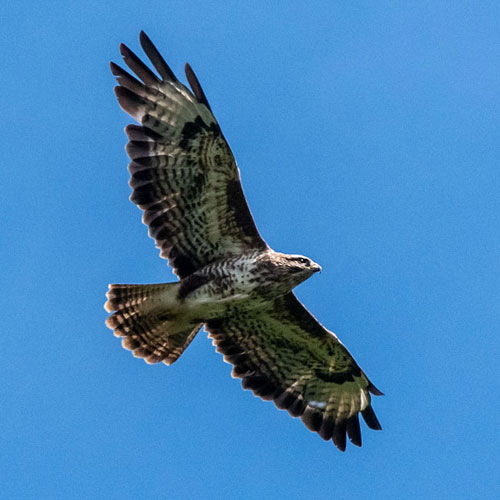 |
Below is a view of the area of the Clyde where the Otter was seen.
Soon after the Buzzard, a Sparrowhawk circled overhead for a short time, but still no Otter. I
headed back downstream towards the Barons Haugh reserve. I nearly stood on a Black Snail
Beetle but stopped in time photograph it. I also got a couple of pleasing shots of Rosebay
Willowherb and a Common Red Soldier Beetle on Ragwort.
| Sparrowhawk |
Black Snail Beetle |
 |
 |
| Rosebay Willowherb |
Red Soldier Beetle |
 |
 |
Once in the Barons Haugh reserve I noticed a young Blue Tit feeding on a Willow tree. I also heard
and then spied a calling Greenfinch perched high in a tree that overlooked the river. Near there I
watched a Common Wasp biting bits off of a bare wooden stump, most probably to use in
building a nest. A Wandering Pond Snail was my next sighting, although it was nowhere near a
pond so it had wandered quite a bit.
| Juvenile Blue Tit |
Greenfinch |
 |
 |
| Common Wasp |
Wandering Pond Snail |
 |
 |
Finally I reached the Causeway Hide and was pleased that it was better illuminated than on the
previous day
The mix of birds was very similar to that seen on Tuesday but there was one significant addition, a
few Black-tailed Godwits were foraging in the shallows. As I left the hide I disturbed a Song
Thrush. It only moved about 10m down the path so I was able to fire off a couple of quick shots.
When I’d finished with the thrush I returned to the car park and was surprised to see in the centre
of the car park, both Magpies and Grey Squirrels getting stuck into a pile of seeds obviously left
by a kindly birdwatcher. One particularly aggressive Squirrel wanted the seeds all to itself since it
chased away any other Squirrel that made a grab for them.
They were still at it as I left for home.
Well my plan of moving my usual weekend visit to midweek to avoid bad
weather worked inasmuch as I made a stack of sightings, which
I’ve documented above. Instead, on Sunday I planned to go to the
pictures to watch the new Oppenheimer movie. However, it turned out
that the weather was ok and I actually spent the day in the park with
my grand-weans. Oh well, as Burns said "the best laid schemes
Week ending: 16th July 23023: Musselburgh
Rain was pelting the west so we headed east to Musselburgh in order to check out the new
nature reserve at Levenhall Links. This is a regeneration of an area that was used to store
waste from Cockenzie Power Station. My WeatherPro app predicted that it would be cloudy with
a chance of the odd shower, but we were willing to risk getting a bit wet in order to see the new
reserve. We first though had another great breakfast in Dalkeith Morrisons (10/10: Excellent; no
complaints, only praise).
The tide was low and rising when we parked at the mouth of the River Esk. There was a strong
wind blowing and some of the gusts were very forceful. As mentioned above. There were many
birds assembled on the very choppy waters. Over 100 Mute Swans were there, along with as
many Goosanders and Eiders a bit further out.
We decided to follow the sea wall out of the the estuary and then turn up onto the new reserve. As
we set off, John spotted pair of Goldfinches on the roof of the corner house and just past the
Cadet Hall I found some Common Mallow growing by the path. on the shore at the sea wall there
were Carrion Crows searching through the seaweed piles for shellfish. A juvenile Carrion Crow
was on a boulder waiting for food from its adult.
| Goldfinch |
Common Mallow |
 |
 |
| Carrion Crow |
Juvenile |
 |
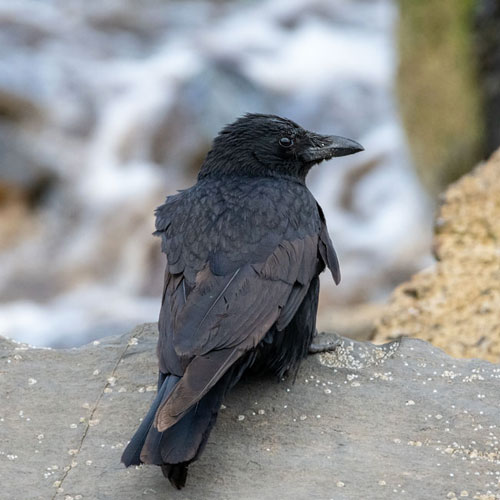 |
Below is a wide angle shot of a raft of over 50 Goosanders bobbing up and down in the estuary.
The light was gloomy but I was pleased to see a lone Redshank meandering along the shore.
Most of the drake Eiders were in dull brown eclipse plumage rather that their more usual
white, black and pale green feathers. Eventually we reached the new tarred path that leads to the
hides of the new scrapes. The short walk to the first of five new hides produced sightings of
wildflowers such as Meadow Vetchling.
I discovered a trio of 7-spotted Ladybirds clinging to a
Creeping Thistle.
| Redshank |
Eider in Eclipse plumage |
 |
 |
| Meadow Vetchling |
7-Spot Ladybird |
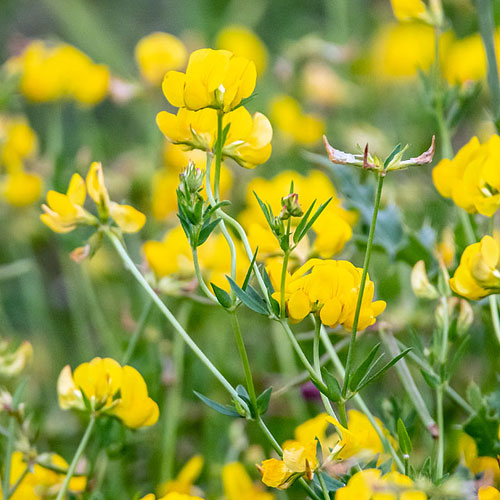 |
 |
The area around the scrapes has been landscaped with many trees planted.
Below are some views of the new scrapes from the first hide we encountered. It wasn’t “packed”
with birds, but there were pockets of gulls and oystercatchers.
The view west over the scrapes has a lovely backdrop of the skyline of Edinburgh and Arthur’s
Seat.
There was a pair of Shelducks and some well-hidden Curlews on the furthest scrape and
eventually we noticed birds nearer the hide, such as a a Pied Wagtail, a couple of Ringed Plovers
and ascending Skylarks.
| Shelduck |
Female Pied Wagtail |
 |
 |
| Ringed Plover |
Skylark |
 |
 |
We had a similar view of the scrapes from the next three hides, but at the last hide (the first if we’d
entered the reserve from a entrance at the end of the park by the cadet hall) we had a nice view of
Leith beautifully illuminated by sunlight.
From inside the hide we saw a fly-past of a trio of Pigeons (probably Feral) and several Greylags
grazing on the grassy banks of a mote that separates the scrapes from all 5 hides. Our initial
impressions of the new reserve were very positive. We both agreed that there were already
promising signs that the birds love it and with time, as the whole ecosystem beds in, it will provide
a very welcome haven for our feathered friends. The new path leads onto the existing path
adjacent to the cadet hall. We passed a patch of Cornflowers growing wild at the very end (or
start) of the new, tarred path. There I also photographed a little white Field Pansy.
| Feral Pigeon |
Greylag Goose |
 |
 |
| Cornflower |
Field Pansy |
 |
 |
After returning to the car we drove to the Levenhall Links car park (off the road to Prestonpans)
and walked to the “old” scrapes. We started at the middle hide where we were delighted to find a
healthy number of birds gathered there, such as Greylags and Black-tailed Godwits. A Roe
Buck galloped past the front of the middle hide, providing a nice photo opportunity.
John spotted a Common Tern on a concrete ring on the rear scrape. I then noticed some
Sandwich Terns, including juveniles, on the opposite side of that scrape. There were also a
few Common and Sandwich Terns in the air and I found a Mallard with a duckling at the back of
the nearest scrape. I could also see a Shelduck dabbling on the scrape to the left of the middle
hide.
We moved to the rightmost hide where we saw a very still Grey Heron on the grass. A Lapwing
appeared briefly before leaving to try its luck elsewhere. On the scrape, very busy Common
Sandpipers were foraging on the damp sands, accompanied by Pied Wagtails and some
juvenile Black-headed Gulls. We next moved into the leftmost hide just as a flock of Curlews
arrived onto the scrapes, displacing some irate Oystercatchers. We were briefly serenaded by a
very loud Goldfinch from its perch high in the bushes behind the hide.
I concluded our old scrapes visit with a nice shot of Canada Geese.
We returned to the car via the seawall adjacent to the scrapes. We were on the lookout for a
single immature King Eider that had been seen there on the previous day. There were over a
hundred eiders roosting close to the sea wall and despite our best efforts we couldn’t find the
King Eider. To be fair, the vast majority of birds had the heads untended pn their wing as they
snoozed. Most were drakes in eclipse plumage but I did snap one drake still bedecked in
breeding plumage. I also got pictures of a low-flying Oystercatcher, a fishing Shag and a couple of
Cormorants. By the path to the car, John found a Buff-tailed Bumblebee on Common Ragwort
and I noticed a flowering Wild Carrot, easily identified by the purple spot in the middle of the
flowerhead. As we sat by the car preparing for tea and strawberry tarts, John noticed two Pill
Woodlouse scuffling out from beneath the car. A nice way to complete the visit.
| Eider |
Oystercatcher |
 |
 |
| Shag |
Cormorant |
 |
 |
|
Buff - tailed Bumblebee |
 |
 |
| Wild Carrot |
Pill Woodlouse |
 |
 |
Although the Sun had remained hidden behind clouds and the wind had been gusty throughout,
we had not been rained upon and we had had plenty to see. The “new” scrapes were a highlight
and we look forward to many return visits there. My favourite shots were of the Roe Deer, the
Ladybirds and the serenading Goldfinch. Hopefully the weather will calm down for next week.
Week ending: 9th July 2023: Maidens ( Map)
Usually my choice of destination for our weekly nature-watching jaunt is decided mainly on where
the best weather will be. This week however, with the whole of Central Scotland predicted to be
treated to generous helpings of sunshine, I had a hankering to visit Maidens (Website), a very lovely
former fishing village on the South Ayrshire Coast. We were last there in September 2022 so it
was due a return visit. We dropped into Ayr Morrisons from the A77 for our customary breakfasts
(8/10: very nice but -2 for a 20 min delay and overcooked black pudding).
The tide was low and the sun was behind clouds when we parked at the Maidens harbour car
park. We always like to start by observing the area around the spit of land between the harbour
and the beach. On our way there, my wee LUMIX TZ70 camera got macro pictures of several
small subjects. The first was some pretty Dovesfoot Cranesbill flowers at the car park. We
followed this with a shot of a Soldier Beetle on Creeping Thistle. John then found a White-tailed
Bumblebee also on Creeping Thistle. I completed the quartet with a pollen-covered Carder Bee on Spear Thistle.
| Dove's - foot Cranesbill |
Red Soldier Beetle |
 |
 |
| White - tailed Bumblebee |
Common Carder Bumblebee |
 |
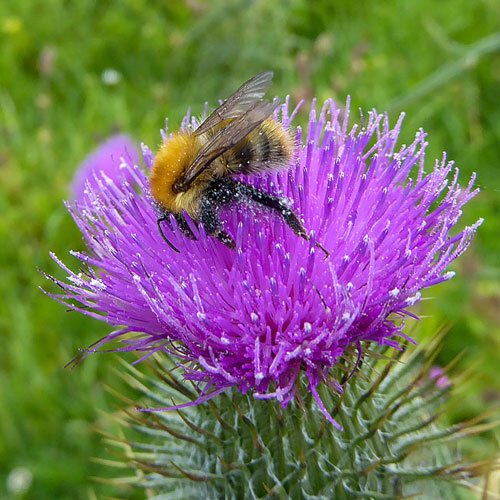 |
We sat for a time scanning the harbour shallows for waders. The first birds to show there,
however, were a couple of Goldfinches, an adult and juvenile, searching the seaweed piles for
invertebrates. I could hear the calls of other birds which I suspected were waders. Sure
enough, a Dunlin emerged from a sandy channel on the harbour, followed by a couple of Ringed
Plovers.
| Goldfinch |
Juvenile Goldfinch |
 |
 |
| Dunlin |
Ringed Plover |
 |
 |
The bird count continued to rise with the arrival of some Oystercatchers and a solitary Curlew. As
I was photographing these, John noticed that we were being watched by a juvenile Rock Pipit
perched on a rock only a few metres from us. Eventually it was joined by an adult.
| Oystercatcher |
Curlew |
 |
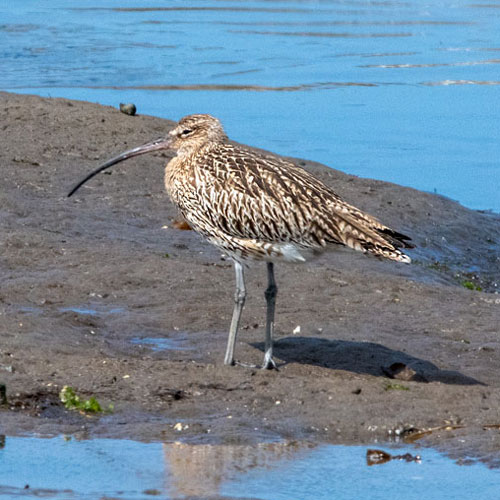 |
| Juvenile Rock Pipit |
Rock Pipit |
 |
 |
The majority of birds in and around the harbour were gulls: Black-headed, Common and
Herring Gulls. I also saw a Great Black-backed Gull on rocks beyond the mouth of the harbour.
| Black - headed Gull |
Common Gull |
 |
 |
| Herring Gull |
Great Black - backed Gull |
 |
 |
A call of, “Incoming!” from John alerted me to a pair of Redshanks that flew past us as we stood
at the water’s edge on the beach.
Also on the rocks with the Great Black-back were a few Shags drying their wings between fishing
dives. At the opposite side of the harbour mouth I saw a young Carrion Crow, searching the rocks
for shellfish. Meanwhile, John was looking in the opposite direction to a Red-breasted Merganser that was standing on an exposed rock just out from the beach. By its plumage I could see it
was an eclipse male. We retraced our steps back towards the car and en route we were pleased
to see a male Linnet standing on a low rock. A pair of Mallards flying towards us from the beach
area caught John’s attention and once again he issued the same alert. I managed a decent
enough picture of the drake, which was in eclipse plumage. A female House Sparrow was our last
shot before leaving the spit of land on our way to explore surrounds of the harbour quay.
| Shag |
Juvenile Carrion Crow |
 |
 |
| Drake Red - breasted Marganser in Eclipse plumage |
Linnet |
 |
 |
| Drake Mallard In Eclipse plumage |
Female House Sparrow |
 |
 |
The first birds we noticed when we began walking along the harbour quay was a pair of Mute
Swans that were paddling between moored boats. These were very easy to photograph. The
same can’t be said of the dozen or so Sand Martins that were darting randomly over the
water and boats catching flies. I attempted lots of pictures and luckily a few were OK. As we
watched a solitary paddle-boarder enter, then leave the harbour, we were thinking that he was not
good for wildlife in the vicinity of the harbour and beach. However he didn’t seem to bother the
Cormorant that appeared below us with a fish (swallowed before I could get a shot, sadly) and
then waddled ashore to dry its wings.
We moved onto a narrow breakwater, shown below, to do a bit of sea watching.
In the time we were on the breakwater we saw a few very distant Gannets (too far off for pictures)
and the “usual” fly-pasts - Curlew, Black-headed and Herring Gulls and another Cormorant. But
that was all.
| Curlew |
Black - headed Gull |
 |
 |
| Herring Gull |
Cormorant |
 |
 |
The picture below is a hazy view of the famous Ailsa Craig - a sign of rain moving up from the
south.
On our walk back to the car John spotted a family of House Sparrows having sand baths on the
edge of a grass-covered sand dune. I was attracted to apples growing on a tree in a garden
beside the dune. We parked ourselves at the edge of the harbour basin, watching for Sandwich
Terns and Wagtails we’d heard earlier. They didn’t show but we were delighted when a pair of
Collared Doves settled about 10m away from where we were sitting. I then photographed
an attractive group of yellow Catsear flowers.
| House Sparrow |
|
 |
 |
| Collard Dove |
Catsear |
 |
 |
We heard a Greenfinch calling from a large patch of Beach Rose bushes by the shore, so we
walked over to investigate. While we tried to locate the finch I came across some interesting
insects: Marmalade and Migrant hoverfies on Sea Mayweed, a few 7-spot Ladybirds on
Creeping Thistles and a busy Red-tailed Bumblebee on yellow Sea Radish flowers. And as we
were homing in on the Greenfinch I snapped yet another female House Sparrow that was
watching us carefully. I at last found the Greenfinch when I went to the other side of the large
group of Rose bushes.
| Marmalade Hoverfly |
Migrant Hoverfly |
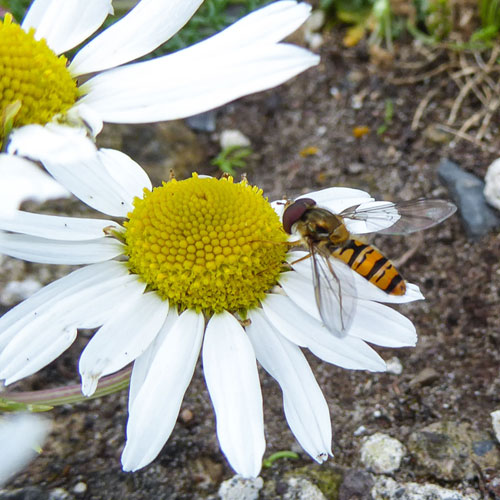 |
 |
| 7 Spot Ladybird |
Red - tailed Bumblebee |
 |
 |
| Female House Sparrow |
Greenfinch |
 |
 |
We had read a report on Twitter of sightings of Black Guillemots, Manx Shearwaters and
Whimbrels along the coast at Turnberry Lighthouse but after such a productive afternoon at
Maidens we decided to give Turnberry a miss. We settled for two cups of tea accompanied by
two strawberry tarts. My favourite pictures of the visit were of the waders, Sand Martins and
Collared Doves. The weather was kind to us, only raining as we had our tea in the car before
driving home. It had been another very enjoyable trip. Hopefully next week’s trip will be just as satisfying.
Week ending: 2nd July 2023: Torness and Belhaven
John and I were on the road again this Sunday after my short holiday. With sharp showers
pounding the west half of Central Scotland, I opted to visit Torness, far in the east. We popped
into Dalkeith Morrisons, as usual, and enjoyed another 10/10 breakfast.
It was sunny when we set off for the concrete walkway that runs along the coast at Torness
nuclear power station, but it was obvious that the very blustery wind was going to have an
influence on our nature-watching activities. We were largely sheltered from the wind by the high
walls of the walkway, as were the very many low-flying Sand Martins that were feeding off
flies that were also gathered there. A couple of Pied Wagtails were also hunting flies. John spotted
a 6-spotted Burnet moth that was having great difficulty flying over the walk due to the
incessant wind. John also found a Meadow Brown butterfly with the same problem.
| Sand Martin |
Pied Wagtail |
 |
 |
| 6 Spotted Burnet Moth |
Meadow Brown Butterfly |
 |
 |
The sea was very choppy due to the gusty wind so there were fewer flypasts that normal. After a
patient wait we did see a Gannet, a Cormorant, a female Goosander and, of course, a ubiquitous
Herring Gull.
| Gannet |
Cormorant |
 |
 |
| Female Goosander |
Herring Gull |
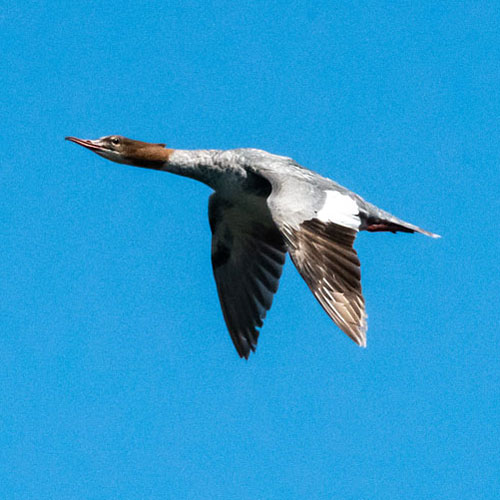 |
 |
Below is the view of Barns Ness Lighthouse and the Bass Rock as seen from the concrete
walkway.
Slightly disappointed with our with our meagre sightings, we decided to set off back to the car. At
the high wall, John spotted some red Mites scurrying along the concrete, probably Trombidium
holosericeum. Also on the walls were a White-lipped Snail and a wandering Ant, probably
Formica lemani,. We climbed the steps that lead to the upper walkway, which is designed
for use in stormy conditions that would render the lower walkway impassable. As we progressed
along the upper walkway we were delighted to see a Skylark standing in front of us, holding an
invertebrate in its beak.
| Mite - Trombidium holosericeum |
White - lipped Snail |
 |
 |
| Ant - Formica lemani |
Skylark |
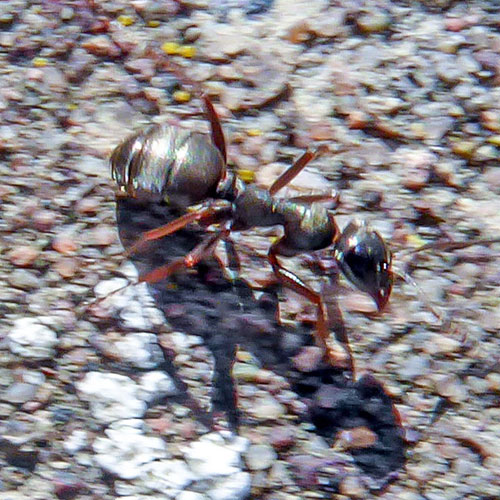 |
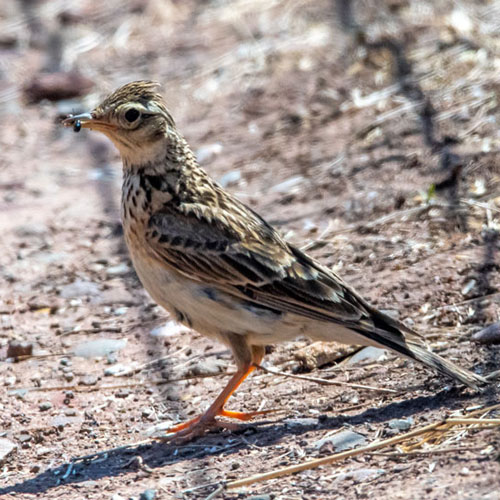 |
Such was the dearth of birds over the water we were very pleased and perhaps relieved to hear
the very familiar sound of approaching Oystercatchers. One or two of them settled on the coastal
defence blocks, which gave me the opportunity to photograph them. I noticed that the Sand
Martins were still dashing along the length of the walkway and even more were doing their stuff
over the grassland at the fringes of the Power station surrounds. As we reached the end of the
upper walkway we could see a gathering of Black-headed Gulls feeding on the rocky shallows at
the northern end of Thorntonloch Beach.
We saw some pretty wildflowers growing on the south side of the upper walkway, such as the
Common Mallow, which is pretty common. Not nearly as common is Chicory, a rather
woody member of the Daisy family. In the past, eg WWII, its roots were roasted and used as a
coffee substitute. I was quite surprised to find Teasel in such an exposed site, as they are
tall (up to 2m). They are often dried and used as indoor decoration. As we left the concrete
walkway I came across a grassy patch of mature flowers of Bladder Campion.
| Common Mallow |
Chicory |
 |
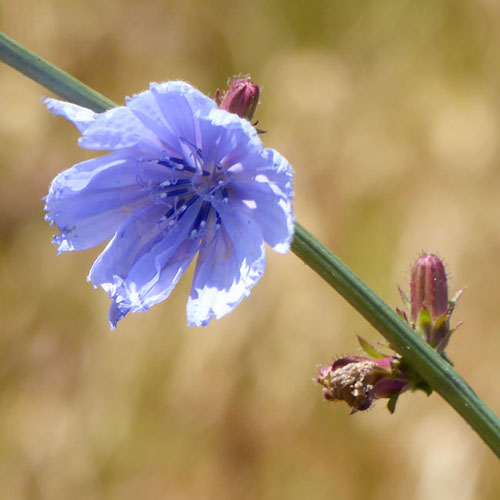 |
| Teasel |
Bladder Campion |
 |
 |
There was a nice surprise just as we reached the car. A beautiful Goldfinch was twittering away
from the top of a Hawthorn tree. I left the car park and took a slight detour along a side road
towards Skateraw in order to check for anything of interest. A juvenile Pied Wagtail was
wandering across the road and, on seeing the car, nipped up a field entrance. I stopped the car
and grabbed my camera and rattled off a couple of shots of it as it disappeared into the field. On
examining the pictures John and I were flabbergasted to see that there was a photobombing
Yellow Wagtail just behind the Pied Wagtail. We hung about for a few minutes but sadly the
Yellow Wagtail didn’t reappear.
We relocated to the Shore Road car park in Belhaven. We were disappointed to find that the tide
was high and there were very few birds on the Inner Bay. The gusty wind had done us again.
However, all was not lost. We walked to the Seafield Pond to try our luck there. Below is the view
from the Inner Bay sea wall of the “bridge to nowhere“ (It’s not really, since it enables people to
get over the burn that remains when tidal waters have receded at low tide).
The pond was quiet also. There were plenty of Mallards with most drakes showing eclipse
plumage. One pair decided to check us out for food. The female was fairly vocal but we had
nothing for them.
Passing dog walkers caused most of the Mallards to take flight.
There were at least three Grey Herons in trees but they were partly hidden or tucked up sleeping
or preening. The only other birds we saw were fleeting views of very distant Moorhens, a fairly
close pair of Coots and a Carrion Crow. I did notice though, as did John, that the short grass was
covered in White Clover flowers which were attracting lots of bees, mainly White-tailed
Bumblebees with a few Red-tailed Bumblebees.
| Coot |
Carrion Crow |
 |
 |
| White - tailed Bumblebee |
Red - tailed Bumblebee |
 |
 |
On our way back to the car I found a large patch of Field Bindweed. I also noticed some aptly
named Large Bindweed, each flower being about three times the size of the Field Bindweed.
There was also Common Mallow by the sea wall. John pointed out a few 7-spotted Ladybirds
amongst the bindweed and as I photographed some of them I noticed a Buff-tailed Bumblebee on a
Spear Thistle.
| Field Bindweed... |
|
 |
 |
| Large Bindweed |
Common Mallow |
 |
 |
| 7 Spot Ladybird |
Buff - tailed Bumblebee |
 |
 |
We started the visit disappointed by the lack of birds to photograph. Having said that I must
observe that we photographed 15 bird species, 9 invertebrate species and 7 flower species - an
eclectic set (as John might say) acquired in tricky conditions. My personal highlights were the
surprise Yellow Wagtail, the trio of bumblebees and all the lovely flowers. Tea and strawberry tarts
were consumed with a sense of satisfaction. Here’s hoping we are as satisfied next week.
Highlights - July 2023
We present this month’s gallery of my
favourite pictures I’ve taken during July 2023. They are
not listed in the order they have been taken, but according to a series
of themes. I’ve kept
commentary to a minimum, preferring to let each picture talk for itself.
BUTTERFLIES
| Comma |
Female Green-veined White |

|

|
| Small Heath |
Small Tortoiseshell... |

|

|
|
Small White |
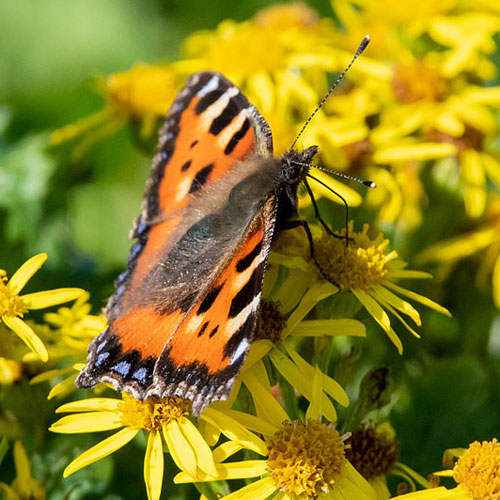
|

|
WINGS I
| Black Guillemot |
Common Buzzard |

|

|
| Gannet |
Female Goosander |

|

|
FLOWERS
| Bittersweet |
Broad - leaved Willowherb |
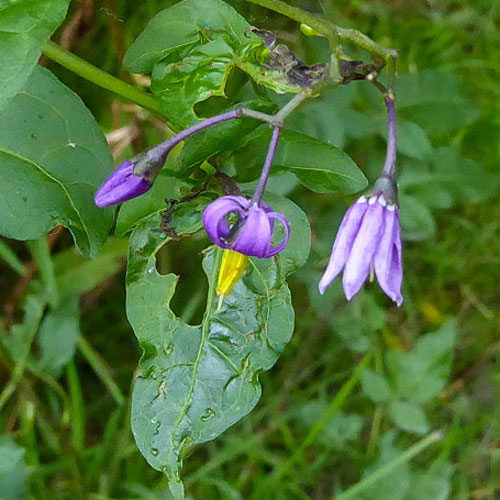
|
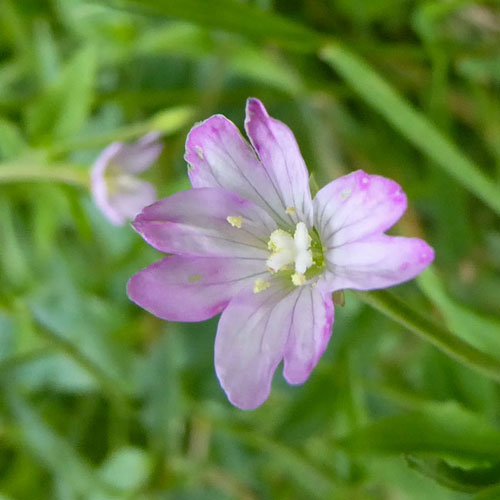
|
| Common Mallow |
Henbit Deadnettle |

|

|
| Meadow Cranesbill |
Yarrow |

|

|
INVERTEBRATES I
| 7 Spot Ladybird |
Black Snail Beetle |

|

|
| Buff - tailed Bumblebee |
Common Carder Bumblebee |

|

|
| Early Bumblebee |
Forrest Shield Bug |

|

|
SHORE BIRDS
| Black Guillemot |
Collared Dove |

|

|
| Dunlin in Breeding plumage |
Juvenile Goldfinch |

|

|
| Green Sandpiper |
Grey Herron |

|

|
| Ringed Plover |
Rock Pipit |
 |
 |
INVERTEBRATES II
| Harlequin Ladybird Var. Conspicua |
Harlequin Ladybird Var. Succinea |
 |
 |
| Honey Bee |
Hoverfly - Syrphus ribesii |
 |
 |
WINGS II
| Herring Gull |
Lesser Black - backed Gull |
 |
 |
| Oystercatcher |
Sand Martin |
 |
 |
| Shag |
Sparrowhawk |
 |
 |
MAMMALS
| Grey Seal |
Grey Squirrel |
 |
 |
| Roe Deer... |
|
 |
 |
Back To Top
|

